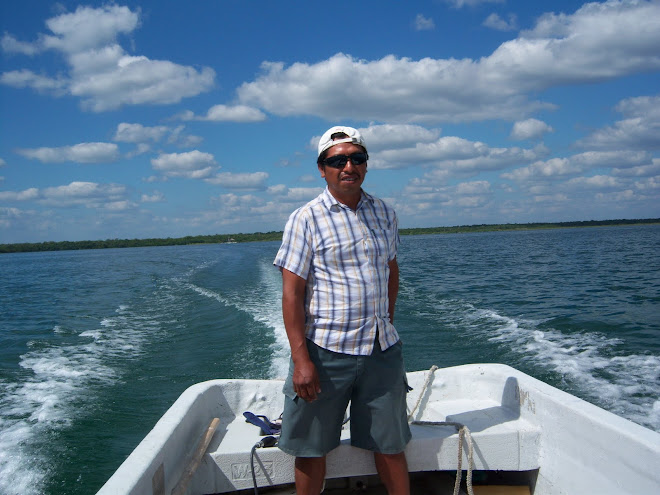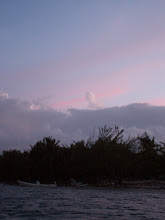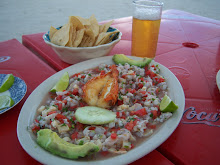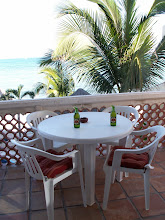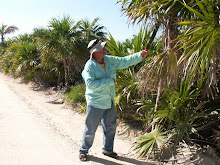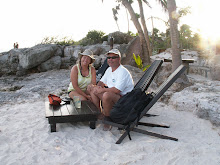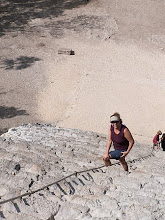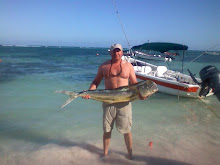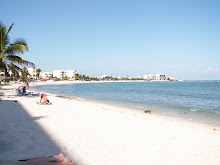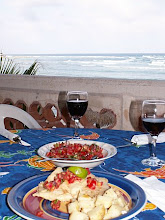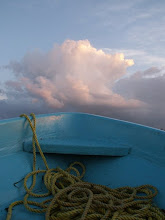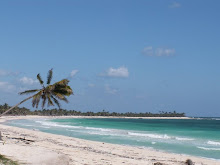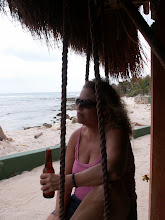The sounds are the quiet and ever present dull roar of the waves on the reef at the mouth of the bay, the louder crash of the small waves at the sandy shore, pushing loose coral, banging together like wind chimes, tinkling as they retreat.
The sound of the palm fronds shading the terrace, clacking in the breeze as they sway, the quiet creak of the hamaca rope, secured in it’s hook as I move to and fro, to and fro. The birds in the trees twitter, call and scold, pelicans glide silently, effortlessly overhead. The sun peeks through the palm to warm my skin. Comfortable now, my book quietly falls to my chest.
My hamaca vida!
Wednesday, March 9, 2011
Monday, July 26, 2010
Uses for an avocado
Avocado is particularly delicious in the Yucatan. The flavor is sweeter, fuller, greener and more buttery than the avocados I buy here on the east coast. It’s so easy to find the perfect ripeness for the day or next couple of days to enjoy. You may also see the larger, rounder avocado. It’s flesh is more yellow, and not as rich tasting.
Score the skin and cut through the flesh down to the pit, moving vertically. When you’ve cut all the way around, twist the two halves in opposite directions to pull them apart. Remove the large pit by tapping it lightly with your knife blade and twisting the avocado off the pit. Carefully push the pit off the knife blade. Score the flesh of each half horizontally in half inch slices and free the slices by running a spoon inside the skin.
Now you have perfect slices of avocado for many uses!
Use on top of salads, fold them into quesadillas, mash it into guacamole, serve with scrambled eggs for breakfast, drizzle with a little olive oil and sea salt, or just a squeeze of lime! Make a sandwich with sliced tomatoes, cube and fold into chicken salad, or eat it plain, avocadoes are full of vitamins, protein and healthy fat so enjoy this healthy treat. Don’t forget to save the skin and rub the remainder all over your face and body! It’s a soothing mask full of nutrients and moisturizers that are so good for your skin. Not too attractive when you have it on, however, so plan that for when you’re alone!
Score the skin and cut through the flesh down to the pit, moving vertically. When you’ve cut all the way around, twist the two halves in opposite directions to pull them apart. Remove the large pit by tapping it lightly with your knife blade and twisting the avocado off the pit. Carefully push the pit off the knife blade. Score the flesh of each half horizontally in half inch slices and free the slices by running a spoon inside the skin.
Now you have perfect slices of avocado for many uses!
Use on top of salads, fold them into quesadillas, mash it into guacamole, serve with scrambled eggs for breakfast, drizzle with a little olive oil and sea salt, or just a squeeze of lime! Make a sandwich with sliced tomatoes, cube and fold into chicken salad, or eat it plain, avocadoes are full of vitamins, protein and healthy fat so enjoy this healthy treat. Don’t forget to save the skin and rub the remainder all over your face and body! It’s a soothing mask full of nutrients and moisturizers that are so good for your skin. Not too attractive when you have it on, however, so plan that for when you’re alone!
Friday, July 9, 2010
People of Mexico
One thing that will strike you when you visit the Yucatan is the people. They are quick to smile or offer help. There is a genuine warmth that perhaps is born of the easy climate.
Many people in the tourist services speak very good English, but don’t let that stop you
from digging out your rusty high school Spanish skills! We have found that many of the
people love to teach you a bit of their language, so don’t be shy about asking about pronunciations or usage. They will often in turn ask you about English words, as they
work on improving their communication with the tourists. I speak a bit of Spanish and love to try to talk to non English speaking Mexican people! As I begin in Spanish, I am frequently understood, but the trouble comes when they answer me back! Yikes, rapid fire conversation ensues and I am quickly lost. Oh well. I try to get them to slow down and can usually pick out the gist of the communication. Even with just a few words in common, sign language and gestures, we are usually able to get our needs met, obtain directions, or learn about the speaker in some way. Their proud smiles and shy nods of the head are heartwarming! Don’t rush to judgment about someone’s clothing or mode of transportation. Here the values run deeper, with family and friendship holding high value. Work to earn the respect of your Mexican hosts who serve you so graciously and you will be rewarded with the warmth that keeps us returning to Mexico year after year.
Many people in the tourist services speak very good English, but don’t let that stop you
from digging out your rusty high school Spanish skills! We have found that many of the
people love to teach you a bit of their language, so don’t be shy about asking about pronunciations or usage. They will often in turn ask you about English words, as they
work on improving their communication with the tourists. I speak a bit of Spanish and love to try to talk to non English speaking Mexican people! As I begin in Spanish, I am frequently understood, but the trouble comes when they answer me back! Yikes, rapid fire conversation ensues and I am quickly lost. Oh well. I try to get them to slow down and can usually pick out the gist of the communication. Even with just a few words in common, sign language and gestures, we are usually able to get our needs met, obtain directions, or learn about the speaker in some way. Their proud smiles and shy nods of the head are heartwarming! Don’t rush to judgment about someone’s clothing or mode of transportation. Here the values run deeper, with family and friendship holding high value. Work to earn the respect of your Mexican hosts who serve you so graciously and you will be rewarded with the warmth that keeps us returning to Mexico year after year.
Wednesday, May 5, 2010
Food..................I love in Mexico!
*The simplest shrimp or fish tacos from small places along the highway. Two plump, batter fried shrimp on a five inch white corn tortilla, shredded cabbage, add your own hot sauce from the assortment on the table. 16 pesos each, about $1.30. Add your $2.00 Dos Equis with all the juicy lime you want and lunch is a bargain. Check out La Floresta or El Oasis, rt. 307 on the service road through Playa del Carmen.
*The flavorful hot sauces, condiments, relishes and pickled vegetables to try! Goodness, every place has a different sauce and the variety is huge. Many restaurants offer the standard salsa with chips, tourist style: chopped tomato, onion (heavy on the onion!), chopped pepper, cilantro and lime. When you venture off the beaten path, the accompaniments reflect the cook’s style. Cooked sauces with deep tomato and smoked dried peppers add real depth to your food when you liberally sauce it, so experiment! Another specialty is pickled vegetables and peppers. When this is on your table, do taste but proceed with caution!
Walk the main street in Tulum pueblo and stop at any street side table where you see locals eating.
*Flat chickens. Chickens are split and laid flat over wood coals, roasted to perfection.
Pick one up in Tulum pueblo on your way to the beach. All ready to go in the box: small whole grilled chicken, chopped into 8 pieces, corn tortillas, rice, cabbage salad and a thin tomato salsa, about $8.00. Try Bronco Chicken on the left as you go south through Tulum Pueblo, service road.
*Mangos. Visit the local produce markets and see variations on mango to expand your palette! Small fruits with slightly banana, citrus, and bitter flavors are wonderful with yogurt smoothies in the morning or sauces for chicken and fish. Larger, dark fruits with lush, juicy characteristics of peach or pear slice up nicely for any meal or right into the blender for mango margaritas.
*The flavorful hot sauces, condiments, relishes and pickled vegetables to try! Goodness, every place has a different sauce and the variety is huge. Many restaurants offer the standard salsa with chips, tourist style: chopped tomato, onion (heavy on the onion!), chopped pepper, cilantro and lime. When you venture off the beaten path, the accompaniments reflect the cook’s style. Cooked sauces with deep tomato and smoked dried peppers add real depth to your food when you liberally sauce it, so experiment! Another specialty is pickled vegetables and peppers. When this is on your table, do taste but proceed with caution!
Walk the main street in Tulum pueblo and stop at any street side table where you see locals eating.
*Flat chickens. Chickens are split and laid flat over wood coals, roasted to perfection.
Pick one up in Tulum pueblo on your way to the beach. All ready to go in the box: small whole grilled chicken, chopped into 8 pieces, corn tortillas, rice, cabbage salad and a thin tomato salsa, about $8.00. Try Bronco Chicken on the left as you go south through Tulum Pueblo, service road.
*Mangos. Visit the local produce markets and see variations on mango to expand your palette! Small fruits with slightly banana, citrus, and bitter flavors are wonderful with yogurt smoothies in the morning or sauces for chicken and fish. Larger, dark fruits with lush, juicy characteristics of peach or pear slice up nicely for any meal or right into the blender for mango margaritas.
Tuesday, March 16, 2010
The Sian Ka'an
For true seclusion, take a drive down through the Sian Ka'an Biosphere. The Sian Ka'an translates to “place where the sky is born” and it feels a magical as that!
First drive through the Tulum beach. The road is all paved now through the commercial area, so the driving is easy. Watch for bicycles and pedestrians, as this area can be congested in spot. Be prepared with water for your drive, as you will not see any place for refreshment for many, many miles! Once you hit the entrance to the Biosphere, the road is dirt, and it can be a little rough in spots. With any recent rain, the puddles will be wide and deep. The road is also a bit narrow, so watch for oncoming traffic as groups of jeeps on tour come barreling up the road from Punta Allen, a sleepy fishing village at the very end of the road. Your patience with the slow drive will be rewarded with gorgeous vistas of blue water and white powder beaches. There are some places to pull over and park, where you can walk for miles and not see a soul. These are wild beaches, fringed with coconut palm and not manicured any sense, therefore, be prepared for some flotsam. Don’t let it spoil your walk, the beauty far outweighs the negative of the garbage. Cross the Boca Paila bridge further down the road and park to meander around this area, spotting fish in the shallows under the bridge. This is where the inland lagoon meets the sea. Make your way to one of the small lodges or go all the way to Punta Allen for a lobster tail lunch. This is an all day excursion, but if you value wide open sea views, wild, untamed beaches and the wonderful feeling of privacy with some adventure, the Sian Ka’an Biosphere is a great place to start!
First drive through the Tulum beach. The road is all paved now through the commercial area, so the driving is easy. Watch for bicycles and pedestrians, as this area can be congested in spot. Be prepared with water for your drive, as you will not see any place for refreshment for many, many miles! Once you hit the entrance to the Biosphere, the road is dirt, and it can be a little rough in spots. With any recent rain, the puddles will be wide and deep. The road is also a bit narrow, so watch for oncoming traffic as groups of jeeps on tour come barreling up the road from Punta Allen, a sleepy fishing village at the very end of the road. Your patience with the slow drive will be rewarded with gorgeous vistas of blue water and white powder beaches. There are some places to pull over and park, where you can walk for miles and not see a soul. These are wild beaches, fringed with coconut palm and not manicured any sense, therefore, be prepared for some flotsam. Don’t let it spoil your walk, the beauty far outweighs the negative of the garbage. Cross the Boca Paila bridge further down the road and park to meander around this area, spotting fish in the shallows under the bridge. This is where the inland lagoon meets the sea. Make your way to one of the small lodges or go all the way to Punta Allen for a lobster tail lunch. This is an all day excursion, but if you value wide open sea views, wild, untamed beaches and the wonderful feeling of privacy with some adventure, the Sian Ka’an Biosphere is a great place to start!
Wednesday, February 17, 2010
More on food...................
Some questions from a guest about chiles rellenos had me longing for this dish and marveling at it’s versatility. Chiles rellenos translates to “stuffed chile” and is a staple on many restaurant menus in the Riviera Maya that feature traditional dishes. Typically this is a roasted fresh pepper with a stuffing of cheese and a coating. There are so many variations to enjoy, and I try them all. I love the chile relleno at the small lunch counter in Akumal. It is a fresh poblano pepper, stuffed with cheese and wrapped in a thin egg omelet, then covered with tomato sauce. The pepper shows just a small amount of heat, the cheese is firm rather than gooey and the tomato sauce smooth and on the sweet side. This is a great breakfast (or lunch or dinner!) dish and is served with black beans and tortillas. Other chiles rellenos I have experience in the area include stuffings of meat and raisins, seafood, or mashed potatoes. The coatings may be an egg batter, bread crumb or nothing. They may be baked or fried, and the peppers can vary widely to include dried chiles or small hot peppers. The sauces also differ, ranging from a simple tomato sauce as described above, to creamy cheese sauces or brown meat based sauces.
The chile relleno represents comfort food of the region to me because it seems each
cook has their own recipe which I imagine comes from the home. It is a more labor intensive dish, but because it is frequently meatless the price is usually low. Try this dish when you travel to the area. It is healthy and delicious!
The chile relleno represents comfort food of the region to me because it seems each
cook has their own recipe which I imagine comes from the home. It is a more labor intensive dish, but because it is frequently meatless the price is usually low. Try this dish when you travel to the area. It is healthy and delicious!
Tuesday, December 22, 2009
Lots of Adventure!
Besides the multitude of ruins in the Yucatan area of Mexico, many other adventures await you. Cenotes, underwater fresh rivers and sink holes offer lots of choices, including snorkeling and diving, as outlined in a previous post. The perfect combination of beautiful beaches and alluring jungle have enticed entrepreneurs to offer adventures that you may not be able to access on your own. Depending on the ages in your group, you may want to check out some of these options!
Aktun Chen is an eco park between Playa del Carmen and Tulum that all ages would enjoy. Here is a small zoo with indigenous animals on display, and you may be surprised to find out what lurks in the jungle all around you! Next you will be led on a walking tour through caves and rock formations, past underground cenotes and waterfalls.
This activity is not too strenuous and is interesting enough to occupy older children.
Xel-ha and Xcaret are two eco/water park facilities that offer all inclusive days with a
variety of activities. From beautiful beaches, to rafting a lagoon, snorkeling a cenote, aviary displays and sea life interaction, these parks are a full day of fun. They also feature good food and traditional entertainment and are a great choice for active families.
There are many options for a jungle treat called Zip-lining. Hidden Worlds and Selvatica are two that are close by. Climb the towering platforms and be hooked into a harness to
fly across the treetops for a birds eye view. Hidden Worlds also features a Sky Cycle, which is a reclining cycle in the trees. These are lots of fun for kids of all ages.
Further north of Playa del Carmen is the Crococun Zoo, a small animal park that showcases (what else) crocodiles and many other local animal species. It offers some animal interaction and kids will be grinning from ear to ear. Great photo opportunities!
Also along the coast are some horse ranches that allow you to live out your fantasy of
galloping along the beach in a tropical paradise.
The Jungle Place is a small, private monkey habitat just west of Chemuyil. Here a couple have built a place where abandoned or injured monkeys are rehabilitated and
cared for in loving attendance. Interaction with the monkeys is strictly monitored and
I have not heard of one person who did not think this was a highly worthwhile adventure.
Other activities available include ATV jungle tours, many types of fishing expeditions,
kayaking or catamaran tours.
If you crave adventure with your paradise, the Yucatan is the place for you!
Aktun Chen is an eco park between Playa del Carmen and Tulum that all ages would enjoy. Here is a small zoo with indigenous animals on display, and you may be surprised to find out what lurks in the jungle all around you! Next you will be led on a walking tour through caves and rock formations, past underground cenotes and waterfalls.
This activity is not too strenuous and is interesting enough to occupy older children.
Xel-ha and Xcaret are two eco/water park facilities that offer all inclusive days with a
variety of activities. From beautiful beaches, to rafting a lagoon, snorkeling a cenote, aviary displays and sea life interaction, these parks are a full day of fun. They also feature good food and traditional entertainment and are a great choice for active families.
There are many options for a jungle treat called Zip-lining. Hidden Worlds and Selvatica are two that are close by. Climb the towering platforms and be hooked into a harness to
fly across the treetops for a birds eye view. Hidden Worlds also features a Sky Cycle, which is a reclining cycle in the trees. These are lots of fun for kids of all ages.
Further north of Playa del Carmen is the Crococun Zoo, a small animal park that showcases (what else) crocodiles and many other local animal species. It offers some animal interaction and kids will be grinning from ear to ear. Great photo opportunities!
Also along the coast are some horse ranches that allow you to live out your fantasy of
galloping along the beach in a tropical paradise.
The Jungle Place is a small, private monkey habitat just west of Chemuyil. Here a couple have built a place where abandoned or injured monkeys are rehabilitated and
cared for in loving attendance. Interaction with the monkeys is strictly monitored and
I have not heard of one person who did not think this was a highly worthwhile adventure.
Other activities available include ATV jungle tours, many types of fishing expeditions,
kayaking or catamaran tours.
If you crave adventure with your paradise, the Yucatan is the place for you!
Thursday, October 1, 2009
Put your face in the water!
Snorkeling is the most fun and exciting thing you can do for free along the Yucatan coast.
You will need a little equipment, some transportation (maybe only your feet!), and the desire to get wet and be amazed!
It is usually best to buy equipment at home so you can try it out and get a good fit, but if you are not planning to purchase equipment, you can easily rent it in Mexico.
We put some money into very good snorkel equipment almost 30 years ago and it is still going strong! (Except the snorkel!) A mask that is tight fitting and comfortable on your face is a must. Fins that will stay on your feet and are a little flexible are best, with either an open back so you can wear snorkel booties, or full fitted to your size foot, which I recommend. The snorkel should be flexible and have an attachment to your mask strap.
Many people like a “dry” snorkel, which allows you to breathe but keeps water out (mostly!). I like a regular snorkel that I can easily clear by blowing hard through the mouthpiece. A snorkel vest, either inflatable or neoprene is important for swimmers who are less comfortable in open water.
I have taught many people to snorkel, and they all agree that it is easily learned in less than an hour. It is a wonderful sensation to put your face in the water and see clearly while breathing! Go slow and look around you, use your fins in very small movements, and do not splash around with your arms. You will find that with very little effort you can glide amongst the fish. Try it out and you will be thrilled in an area like the Yucatan Coast.
The coastline offers many opportunities for snorkelers. From freshwater caves called cenotes where your view is beautiful underwater stalagmites, to offshore reefs reached by boat, you will have many choices. Along the shoreline, inlets and lagoons mix the freshwater underground streams with the sea and sealife takes shelter for your viewing pleasure. Some bays along the coast have reef protecting the mouth and offer fabulous snorkeling a short swim from shore, whereas in other spots the reef is a mile or more away from the beach and must be reached by boat.
Some great opportunities exist to snorkel amongst sea turtles, the gentle giant whalesharks, dolphins and more. Other creatures you are sure to see are hundreds of species of the most colorful fish ever seen, rays of all size and pattern, spiny lobsters,
octopus, crabs, eels, and sea urchins, star fish, and too many more to mention!
Some of these underwater areas are marine protected areas, but most are not. Be a good snorkeler and NEVER stand on any coral or reef! The coral is a living creature and your abuse will kill it. Never touch the coral, or any of the sea creatures you encounter, and never remove anything from the sea. Only snorkel on calm days and watch for currents. Always be familiar with the area you plan to snorkel. You can get information from local dive shops, locals and several books, internet sources and veteran snorkelers. Always snorkel with a buddy for safety
Snorkeling is a great, inexpensive hobby that any age can enjoy and the Yucatan coast offers some of the best snorkeling anywhere. Don’t miss it!
You will need a little equipment, some transportation (maybe only your feet!), and the desire to get wet and be amazed!
It is usually best to buy equipment at home so you can try it out and get a good fit, but if you are not planning to purchase equipment, you can easily rent it in Mexico.
We put some money into very good snorkel equipment almost 30 years ago and it is still going strong! (Except the snorkel!) A mask that is tight fitting and comfortable on your face is a must. Fins that will stay on your feet and are a little flexible are best, with either an open back so you can wear snorkel booties, or full fitted to your size foot, which I recommend. The snorkel should be flexible and have an attachment to your mask strap.
Many people like a “dry” snorkel, which allows you to breathe but keeps water out (mostly!). I like a regular snorkel that I can easily clear by blowing hard through the mouthpiece. A snorkel vest, either inflatable or neoprene is important for swimmers who are less comfortable in open water.
I have taught many people to snorkel, and they all agree that it is easily learned in less than an hour. It is a wonderful sensation to put your face in the water and see clearly while breathing! Go slow and look around you, use your fins in very small movements, and do not splash around with your arms. You will find that with very little effort you can glide amongst the fish. Try it out and you will be thrilled in an area like the Yucatan Coast.
The coastline offers many opportunities for snorkelers. From freshwater caves called cenotes where your view is beautiful underwater stalagmites, to offshore reefs reached by boat, you will have many choices. Along the shoreline, inlets and lagoons mix the freshwater underground streams with the sea and sealife takes shelter for your viewing pleasure. Some bays along the coast have reef protecting the mouth and offer fabulous snorkeling a short swim from shore, whereas in other spots the reef is a mile or more away from the beach and must be reached by boat.
Some great opportunities exist to snorkel amongst sea turtles, the gentle giant whalesharks, dolphins and more. Other creatures you are sure to see are hundreds of species of the most colorful fish ever seen, rays of all size and pattern, spiny lobsters,
octopus, crabs, eels, and sea urchins, star fish, and too many more to mention!
Some of these underwater areas are marine protected areas, but most are not. Be a good snorkeler and NEVER stand on any coral or reef! The coral is a living creature and your abuse will kill it. Never touch the coral, or any of the sea creatures you encounter, and never remove anything from the sea. Only snorkel on calm days and watch for currents. Always be familiar with the area you plan to snorkel. You can get information from local dive shops, locals and several books, internet sources and veteran snorkelers. Always snorkel with a buddy for safety
Snorkeling is a great, inexpensive hobby that any age can enjoy and the Yucatan coast offers some of the best snorkeling anywhere. Don’t miss it!
Tuesday, September 1, 2009
Margarita time!
One of the highlights of our journeys to Mexico is always the margaritas. Many place have their particular recipes, and it’s great fun to try them out! Order the best tequila you can afford, I have found it worth it the next morning! One specialty you will find it the mango margarita. This is a frozen drink, and really refreshing. My husband prefers a classic margarita on the rocks with salt. We also make awesome Margaritas right in our kitchen in Mexico, and with the right ingredients, it’s easy. Of course, the most important component is the tequila, and I like 100% Agave. The range of tastes in tequila will astound you, so taste many and find your own favorite. Next comes the lime. The limes in Mexico are small and hard, usually, so a juicer comes in very handy to produce the quantity of juice that we like. The other important part is the Contoy, or Cointreau, which is an orange liquer. Finally, a spash of simple syrup (or even 7-up) will balance all the flavors. One of my favorite add-ins, besides fresh mango, is pomegranate juice. Whiz in a blender full of ice and pour into a real glass rimmed in salt, and it’s Happy Hour!
Friday, August 28, 2009
Mayan Ruins
One of the most spectacular sights in the Yucatan area are the Mayan ruins that
populate this region. From small ruins on the side of the road or glimpsed through the jungle, to palatial structures that dominated ancient cities, there is much to see.
A basic guide book for the area, such as a Fodor’s or Frommer’s will give you a lot of information to digest and is a good start. Read these or something similar before you
go for a quick orientation. The best way to really enjoy the ruins, however, is to hire a guide near the admissions gate. These are educated and authorized people who speak
the language you require and are worth every penny of their charge. (Approx $40 for
a tour of a large ruin site such as Chichen Itza.)
When you hire a guide, you are able to follow along and really enjoy the sights. They
can bring history alive and conjure visions of mighty empires stretching for a thousand miles through the jungles, royal hierarchies battling for supremacy, and common people
laboring for the beauty still standing before you.
There are many Mayan ruins all reachable in a day trip from the Yucatan coast, the largest and most impressive being Chichen Itza. The last time we visited, about five years ago, you were still permitted to climb the great Castillo or pyramid, and also to
climb the inner staircase to the beautiful Jaguar altar. Alas, these are now closed to the
public, but there is still much to marvel over in this gorgeous city of stone.
Many Mayan ruins are lesser known and still under excavation. The ruins of Coba, just west of Tulum is one of these, and features another great pyramid that is still able to be climbed. This is a great site to explore, as it retains much of it’s jungle setting which creates a cooler (temperature-wise) and more atmospheric environment.
There are dozens of ruins scattered throughout the area, check your guide book and go explore these mystic marvels!
Some hints for seeing the ruins:
-Go early! Tour buses often arrive about 10am. Get there when the site opens, often 8am and you will have the place to yourself for awhile.
-Bring water and a hat. The sun is fierce inland and you will need hydration.
-Wear sturdy shoes. The ruins often cover vast areas, and good shoes will allow you to
explore and climb at will, if permitted.
-Which brings me to the last point: PLEASE obey posted signs regarding climbing or touching the ruins! You are a guest at a heritage site and manners are required!
populate this region. From small ruins on the side of the road or glimpsed through the jungle, to palatial structures that dominated ancient cities, there is much to see.
A basic guide book for the area, such as a Fodor’s or Frommer’s will give you a lot of information to digest and is a good start. Read these or something similar before you
go for a quick orientation. The best way to really enjoy the ruins, however, is to hire a guide near the admissions gate. These are educated and authorized people who speak
the language you require and are worth every penny of their charge. (Approx $40 for
a tour of a large ruin site such as Chichen Itza.)
When you hire a guide, you are able to follow along and really enjoy the sights. They
can bring history alive and conjure visions of mighty empires stretching for a thousand miles through the jungles, royal hierarchies battling for supremacy, and common people
laboring for the beauty still standing before you.
There are many Mayan ruins all reachable in a day trip from the Yucatan coast, the largest and most impressive being Chichen Itza. The last time we visited, about five years ago, you were still permitted to climb the great Castillo or pyramid, and also to
climb the inner staircase to the beautiful Jaguar altar. Alas, these are now closed to the
public, but there is still much to marvel over in this gorgeous city of stone.
Many Mayan ruins are lesser known and still under excavation. The ruins of Coba, just west of Tulum is one of these, and features another great pyramid that is still able to be climbed. This is a great site to explore, as it retains much of it’s jungle setting which creates a cooler (temperature-wise) and more atmospheric environment.
There are dozens of ruins scattered throughout the area, check your guide book and go explore these mystic marvels!
Some hints for seeing the ruins:
-Go early! Tour buses often arrive about 10am. Get there when the site opens, often 8am and you will have the place to yourself for awhile.
-Bring water and a hat. The sun is fierce inland and you will need hydration.
-Wear sturdy shoes. The ruins often cover vast areas, and good shoes will allow you to
explore and climb at will, if permitted.
-Which brings me to the last point: PLEASE obey posted signs regarding climbing or touching the ruins! You are a guest at a heritage site and manners are required!
Subscribe to:
Posts (Atom)


